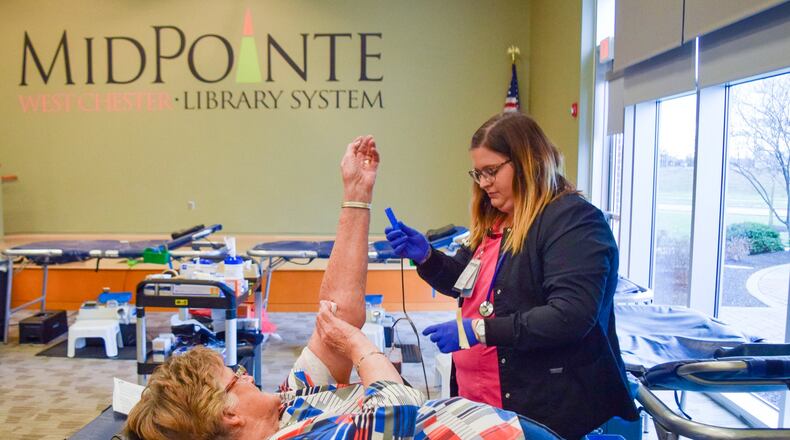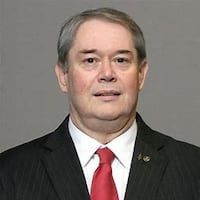“From November to about mid-December, people were coming out to donate blood. Our blood supply was at 95 percent before Christmas,” Nicolas said. “Our supplies got hit over the weekend and there is a need for O-positive and A-negative blood.”
A unit of whole blood has a 42-day shelf life, while a unit of platelets has a five-day shelf life. One unit of whole blood can save up to three lives. Nicolas said blood is something that cannot be created in a lab which is why it’s important to donate regularly.
Nicolas said the Hoxworth organization has a need for about 400 blood donations and 50 plasma donations per day for the 30 hospitals and medical centers in the 18 counties in southwest Ohio, northern Kentucky and southeast Indiana. Hoxworth, the nation’s second-oldest blood bank that was founded in 1938, is a division of the University of Cincinnati. The organization collects about 90,000 units of blood per year through blood drives and its seven donation centers.
“The need is always there,” she said. “We never have a time that there’s not someone using blood. Flu season hits us hard and we need people to donate after the holidays.”
Community Blood Center was started in 1964 to serve two Dayton hospitals. By 1967, CBC was serving 24 area hospitals in a 15-county area that includes 12 Ohio counties and three east central Indiana counties. It now serves 23 area hospitals. In 2019, CBC collected 68,209 units, up from 66,123 units in 2018.
“CBC is looking to maximize collections in 2020,” Pompilio said. “We have a need for about 250 blood donations a day.”
Both organizations are planning promotions as part of National Blood Donation Month that started this week. This is also the second annual Ohio Blood Donor Awareness month.
From Saturday through Feb. 29, CBC will be harnessing the “Dayton Strong” movement to inspire more blood donors and blood drive sponsors by offering a white, long-sleeve T-shirt with red “Donor Strong” lettering is a gift to everyone who registers. Pompilio said CBC received more than 1,700 blood donations after the Oregon District shootings in August.
Hoxworth is offering a winter scarf for donors from Wednesday through Jan. 13.
in observance of New Year’s Day, but donor centers and blood drives will be open on Thursday.
In the Cincinnati region, Hoxworth donors can schedule their donation by calling (513) 451-0910 or by visiting www.hoxworth.org.
In the Dayton region, CBC donors can make an appointment online at www.DonorTime.com or call (937) 461-3220.
Blood Facts
4.5 million Americans will a need blood transfusion each year.
43,000 pints: amount of donated blood used each day in the U.S. and Canada.
Someone needs blood every two seconds.
Only 37 percent of the U.S. population is eligible to donate blood - less than 10 percent do annually.**
Blood drives hosted by companies, schools, places of worship and civic organizations supply roughly half of all blood donations across the U.S.
One pint of blood can save up to three lives.
94 percent of blood donors are registered voters.
Three pints: the average whole blood and red blood cell transfusion.*
A patient could be forced to pass up a lifesaving organ, if compatible blood is not available to support the transplant.
The actual blood donation usually takes about 10 minutes. The entire process - from the time you sign in to the time you leave - takes about an hour.
*Source: The 2007 Nationwide Blood Collection and Utilization Survey Report, Department of Health & Human Services.
**W Riley, et al. The United States’ potential blood donor pool: estimating the prevalence of donor-exclusion factors on the pool of potential donors. Transfusion 2007.
*Source: The 2007 Nationwide Blood Collection and Utilization Survey Report, Department of Health & Human Services.
**W Riley, et al. The United States’ potential blood donor pool: estimating the prevalence of donor-exclusion factors on the pool of potential donors. Transfusion 2007.
HOW TO DONATE BLOOD
Hoxworth blood drives planned:
Jan. 9, 1 to 3 p.m., Progressive Insurance Service Center, 2669 E. Kemper Road, Cincinnati.
Jan. 10, noon to 6 p.m., Explosion Fitness Center, 530 Quality Blvd., Fairfield.
Jan. 12, 9 a.m. to 3 p.m., Kroger, 5100 Terra Firma Drive, Mason.
Jan. 17, 8 a.m. to 2 p.m., Monroe City Building, 233 S. Main St., Monroe
CBC blood drives/bloodmobiles planned:
Today, 3:30 to 7 p.m. at Springboro Christian Church, 720 S. Main St., Springboro.
Friday, 4 to 7 p.m., Ohio Blood Donor Awareness Month Kickoff Blood Drive, at the CBC, 349 S. Main St., Dayton.
Monday, 3 to 7 p.m. at Queen of Peace Catholic Church at 2550 Millville Ave., Millville.
Wednesday, 1 to 4 p.m. at the Liberty Savings Bank at Polaris, 3435 Airborne Road, Wilmington.
Wednesday, noon to 6:30 p.m. at the CMH Regional Health System, 610 West Main St., Wilmington.
About the Author

